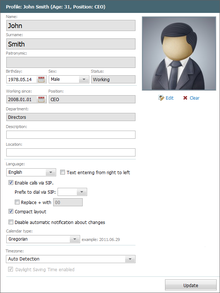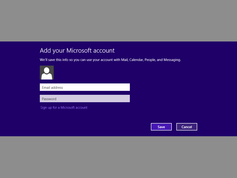User profile
A user profile is a collection of settings and information associated with a user. It contains critical information that is used to identify an individual, such as their name, age, portrait photograph and individual characteristics such as knowledge or expertise.[1] User profiles are most commonly present on social media websites such as Facebook, Instagram, and LinkedIn; and serve as voluntary digital identity of an individual, highlighting their key features and traits.[2] In personal computing and operating systems, user profiles serve to categorise files, settings, and documents by individual user environments, known as ‘accounts’, allowing the operating system to be more friendly and catered to the user.[3] Physical user profiles serve as identity documents such as passports, driving licenses and legal documents that are used to identify an individual under the legal system.
A user profile can also be considered as the computer representation of a user model. A user model is a (data) structure that is used to capture certain characteristics about an individual user, and the process of obtaining the user profile is called user modeling[4] or profiling.
The origin of User Profiles can be traced to the origin of the passport, or an identity document (ID) made mandatory in 1920, after World War 1.[5] The passport served as an official government record of an individual. Consequently, Immigration Act of 1924 was established to identify an individual’s country of origin. In the 21st century, passports have now become a highly sought-after commodity as it is widely accepted as a source of verifying an individual’s identity under the legal system.[6]
With the advent of digital revolution and social media websites, user profiles have transitioned to an organised group of data describing the interaction between a user and a system.[7] Social media sites like Instagram allow individuals to create profiles that are representative of their desired personality and image. Filling all fields of profile information may not be necessary to create a meaningful self-presentation, which grants individual more control over of the identity they wish to present by displaying the most meaningful attributes.[8] A personal user profile is a key aspect of an individual's social networking experience, around which his/her public identity is built.[9]
A user profile can be of any format if it contains information, settings and/or characteristics specific to an individual. Most popular user profiles include those on photo and video sharing websites such as Facebook and Instagram, accounts on operating systems, such as those on Windows and MacOS and physical documents such as passports and driving licenses.
Effectively structured user profiles on social media channels such as Instagram and Facebook offer a way for people to form impressions about someone that is predictive or similarly meeting them offline.[9] The condensed format of social media profiles allows for quick filtering of millions of profiles by matching individuals by similar characteristics and interests; information provided upon sign up. A research conducted highlights that only a “thin slice”[7] of information is required to form an impression about an individual online (Stecher and Counts 2008). Online user profiles eliminate the complexity of interaction that is present in ‘face-to-face’ meetings such as behavioural, facial, and environmental information, resulting in increased predictiveness of user personality.[10]



